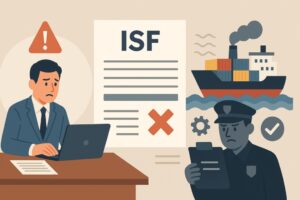
Importers are required to file an Importer Security Filing (ISF) with U.S. Customs and Border Protection (CBP) at least 24 hours before goods are loaded onto a vessel bound for the United States. If you’re wondering how critical accuracy is, the answer is simple: very. An incorrect or late ISF submission can lead to fines, shipment delays, and heightened inspection risks. Even small errors can result in costly consequences, which is why understanding the impact, and how to fix mistakes, is crucial for any importer.
What Happens When There’s a Mistake
Making an error on your ISF doesn’t go unnoticed. Customs uses the information in the filing to assess risk and determine admissibility. Mistakes in key data, like incorrect bill of lading numbers, container stuffing locations, or missing manufacturer information, can result in the ISF being deemed non-compliant. This triggers automatic penalties of up to $5,000 per violation. Multiple errors can result in compounded fines or even hold shipments at the port.
Errors may also cause a shipment to be flagged for intensive examination. These inspections can delay delivery for days or even weeks and come with added costs, which the importer must cover. Even clerical errors, such as typos in name fields, can complicate automated processing and lead to unnecessary red tape.
Common ISF Errors to Avoid
Some of the most frequent ISF mistakes include:
- Filing with the wrong bill of lading number
- Failing to include all required data elements
- Mixing up manufacturer and supplier information
- Listing the incorrect buyer or consignee
- Using placeholder or estimated data that isn’t updated
- Missing the 24-hour pre-loading deadline
Each of these errors undermines the reliability of the information provided to CBP and opens the door to penalties.
How to Fix a Mistake on Your Filing
If you realize you’ve made a mistake after submitting the ISF, don’t panic, but act quickly. The ISF can be amended through the Automated Broker Interface (ABI) system used by your customs broker or freight forwarder. Corrections are allowed as long as they are made before the vessel arrives at the U.S. port.
It’s best to notify your broker immediately and provide accurate replacement data. They can electronically submit an amendment to update CBP’s records. Keep in mind that changes after arrival are much more difficult and may still result in a penalty, even if corrected. However, showing a good-faith effort to amend errors before arrival may work in your favor if CBP reviews the issue.
Tips for Preventing Future Errors
To avoid repeat mistakes:
- Double-check all data before submission
- Coordinate with suppliers and freight forwarders for accuracy
- Work with a licensed customs broker familiar with ISF requirements
- Set internal deadlines earlier than the 24-hour minimum
- Store accurate records of every ISF for future reference
Implementing a reliable ISF workflow will reduce your risk of penalties, delays, and cargo holds.
Conclusion
An ISF submission is not just a bureaucratic step. It’s a critical compliance requirement. Errors, even minor ones, can have major consequences. The good news is that most mistakes can be fixed if caught early. With vigilance, good communication, and prompt corrective action, importers can avoid unnecessary costs and keep their supply chains running smoothly.




Leave a Reply